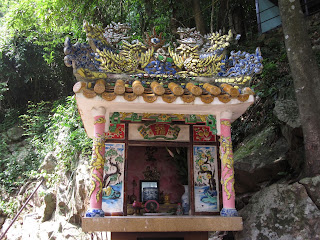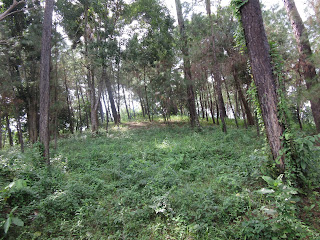Photos from our Dragon Boat trip:
There were about 25 other people on the dragon boat, half of them from Vietnam but I was lucky that no one else wanted to snag a seat up by the captain so I had great views the whole boat trip.
You can possibly just see the Citadel's flag in the background. Another day, another day of haze unfortunately.
A stowaway on board!
Washing laundry in the river.
Cutting away the underbrush which seemed like a never ending job.
Approaching our first stop of the day, note the landing dock below!
Photos from An Han Garden House:
It was great getting off the boat and being able to wander around a bit. The house was built 118 years ago and the last king of Vietnam gave the home to the family before he left the country in 1945 for Paris, never to return again. The family earns money from tourists paying the 20VND (less than a dollar) entrance fee.
The family temple

We were all served tea while being told about the house which was divided into 3 separate areas; the left was reserved for men, the right for women and the central area where we were for the entire family.
Mangosteen fruit trees in the backyard.
Back to the boat and onto Thien Mu Pagoda, only 7 minutes away.
The parking lot for the dragon boats!
Peering into an adjacent boat!
Approaching the Thien Mu Pagoda, we saw a large group of young people carrying individually wrapped roses that were presented to each woman in our group because October 19th was Happy Women's Day!Photos of Thien Mu Pagoda:
Often called the symbol of Hue, Thien Mu is one of the oldest and loveliest religious structures in Vietnam. It was built beginning in 1601.
The Pagoda's Phuoc Duyen Tower, above, was added in 1844; each of its 7 towers is dedicated to either one of the human forms taken by Buddha or the 7 steps to enlightenment, depending on whom you ask!
The stele I mentioned above inscribed with a biography of the temple's founder.
Once through the main gates, we saw a complex of monastic buildings.
There was real facial hair on the 12 huge wooden sculptures of fearsome temple guardians!
Monks' living quarters at the pagoda.
Could hear the gong ringing as we saw kids returning from school.
At the rear of the pagoda with its beautiful pine trees, we saw the monks' graveyard.
The tortoise statue was in the shrine below.
Back in the boat about 10:45 where we continued upriver away from Hue and the traffic along the riverfront. Soon noticed the much hillier terrain.
We were served a lovely communal lunch of rice, tofu, vegetables and pork, etc while on the boat.
Fishermen tending to their nets.
Photos from Hon Chen Shrine where we stopped for a few minutes:
Wish I had thought of asking the significance of wooden horse sculptures in Vietnamese shrines and temples as we sure saw a lot of them.
It was amazing seeing boats that were so low to the water. You just hope that no strong gust of wind or large wave comes along to sink them.
Photos from Minh Mang Tomb:
Minh Mang Tomb was our next destination. Minh Mang was one of the most popular Nguyen emperors and the father of the last emperor Bao Dai and an astounding 113 other children. The tomb is the place to live in when you die, our guide explained.
Our really good guide for the entire day who explained that the three steps below signify earth, god and humanity.
Walked through the gates where we saw the Minh Pavilion ahead which is also known as the Pavilion of Light. The pavilion, built in 1841, symbolizes the emperor's last step over before arriving at the final resting place.
The Minh Mang Tomb was very similar in design to the Citadel in Hue with many shrines all connected by a seemingly endless number of steps to ascend and then descend. There was though a tremendous sense of peace and also reverence at Minh Mang.
Only parkland there but at least I had bragging rights after ascending the final steps!
Photos as we traipsed back to the bus at Minh Mang:
Sometimes the Google translate button just doesn't work!
We go back aboard the bus and arrived at Khai Dinh's Tomb at 1:40. Photos from his tomb:
Khai Dinh's Tomb, completed in 1931, is one of Hue's wonders. The emperor himself wasn't particularly revered as he was overly extravagant and flamboyant even reportedly wearing a belt studded with lights that he flicked on at opportune public moments!
His tomb, a gaudy mix of Gothic, Baroque, Hindu and Chinese architecture, at the top of 127 very steep steps, is a reflection of the man.
Bet you figured out by now how much I liked photographing the mandarins or emperors' chief assistants!
Inside, the 2 main rooms were completely covered with fabulous, intricate glass and ceramic mosaics in designs reminiscent of Tiffany and Art Deco - just outstanding but also seemed so out of place when compared with the other tombs we had just seen.
The ceiling was painted by a man who used both his hands and feet to paint in what some say was a sly mark of disrespect for the emperor.
I think everyone on the tour had seen quite enough of Khai Dinh's opulent tomb and was quite happy to take a break a while later when we stopped for 'Royal Tea' also known as Minh Mang whiskey made from rice paste.
Everyone was invited to drink free of charge some of the 30% ethanol whiskey and eat some crackers.
That's ginseng in the bottle.
With everyone on the bus a little happier now, we were then driven to an incense makers' village, getting there after 2:30.
I just loved the colors so much I wanted to buy all the sticks up!
Our guide said that everyone in Vietnam uses incense sticks regardless of their religion. They are made from bamboo, cinnamon, sawdust and other materials that are all mixed with water to make the dark brown compound above that the woman then made into sticks.
Photos from Tu Duc's Tomb:
Tu Duc's Tomb was our last tomb of the day and, no, we didn't mind too much as we were getting 'tombed out'!
Tu Duc 's Tomb is also called the 2nd Imperial City. Tu Doc had the longest reign of any Nguyen dynasty emperor, from 1847-1883. He was a philosopher and scholar of history and literature but he had a very tough reign. His kingdom unsuccessfully struggled against French colonialism, he fought a coup d'etat by members of his own family and, though Tu Duc had 104 wives, he had no heir (he had mumps as a child).
The 'tomb' was constructed from 1864-67 and also served as a recreation grounds for the king as it was completed 16 years before his death.
Tu Duc actually engraved his own stele, above, which is the largest in Vietnam.
A hornets' nest in the stele area!
Photos of Tu Duc's Bu Thanh & Huyen Cung:
Bu Thanh means a round wall that protects the emperor's tomb. The tomb was only opened on the anniversary of his death. Huyen Cung means the underground palace where his corpse was placed.
The above photos were all of the Bu Thanh and Huyen Cung, i,e, where Tu Duc was actually buried. We then walked back to the bus to join the other passengers who had been shopping because only 5 of us had paid to enter the Tu Duc's Tomb.
Tu Duc's glorious and massive tomb complex was a wonderful way to end our 8 hour tour of Hue's Imperial Tombs. It still boggles my mind that we only had to pay $7 each for getting picked up at the hotel, the really fun dragon boat ride up the Perfume River, lunch aboard the boat, our amazing guide, the bus ride to all the tombs AND the 'Royal Tea' and incense making village stops.
Back in Hue, I was presented with yet another rose by another group of students all dressed in yellow and red. How lucky was I!
Posted on 10/27 from Ninh Binh, Vietnam.





















































































































































I just saw mangosteen fruit today when I stopped at the Asian market on my way home. I didn't buy any though as they were pricey and I didn't know if I would like them!
ReplyDeleteI just saw mangosteen fruit today when I stopped at the Asian market on my way home. I didn't buy any though as they were pricey and I didn't know if I would like them!
ReplyDeleteLoved the colorful dragon boats.
ReplyDelete